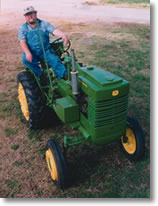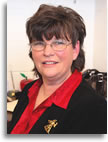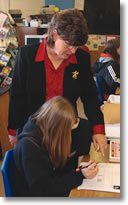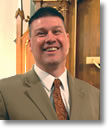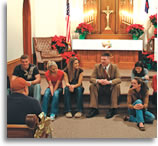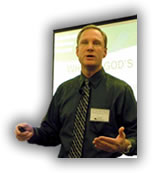by Roland Lovstad
This Is Where I Belong
as a new pastor, one of the first things Rodney “Sarge” Fritz learned was how to play pinochle. “I said I didn’t know how to play, and the people said they’ll teach me,” he recalls. “And I learned a lot.” Fritz came to know his members, learn about the struggles and joys of rural America, and hear their questions about faith and life. And he learned something else: “There’s a respect that comes with the office of the pastor that’s pretty automatic in rural America, but you’ve got to earn the members’ trust.”
|
|
|
Rev. Rodney Fritz |
Twenty-nine years and counting, Fritz is serving his first call as pastor of Trinity Lutheran Church in Hanover in north-central Kansas. Based on the experience, he has some things he hopes to share as a member of the Kansas District Board of Directors and its Rural Small-Town Ministry Committee. His dream is to develop a presentation to introduce new professional workers to rural and small-town ministry.
“I guess the biggest lesson I would tell them is this: Learn the history of the congregation and the culture where you serve. And that’s going to take a while,” he says.
Fritz fears that rural congregations—often the first call for a seminary graduate—are considered by pastors as a stepping stone to some place “bigger and better.” Congregations often develop a sense that their pastor is not going stay for any length of time; so they are hesitant to adopt new programs.
At one time, a majority of pastoral candidates came from rural areas, Fritz observes. Today, the largest number comes from urban-suburban backgrounds. He admits that rural America may not be able to offer large and beautiful choirs, multiple church staffs, parochial schools, or even secretaries— and the nearest hospital or Wal-Mart may be 40 miles away. Yet, a vital ministry can take place.
“There are people who need pastoral care. If you give yourself time to grow in the community and work with the people, they will love you to death,” Fritz says.
|
|
|
Rev. Rodney Fritz collects all things John Deere |
His advice for a new pastor is straightforward: If rural ministry is new to you, admit it. Ask your congregation to help you understand. Also, Fritz advises patience, because change in a congregation can come slowly. The congregation needs to understand that a new pastor wants to bring the Word, and that he has a heart to do things for the Lord.
Whether the pastor asks or a member invites, there should be rides on the combine, home visits, circulation among business and gathering spots in town, and lots of conversation. “People here in rural America, they wave,” Fritz explains. “You talk to everybody. They may not be your members, but when you’ve been out among them enough, you gain their trust.”
The best advice he received was to shut the office and accept the invitation to celebrate a birthday with a family, even if work is piled high on his desk.
“It just means being out among them, doing the best you can, laughing with them, crying with them,” he continues. “When you mess up, you say, ‘I’m sorry; forgive me.’ And you continue on, because they will come to you and talk about their hurts and their struggles, and you can always pronounce that good news that Jesus does forgive, and He’s going to be with them through every struggle.”
After 29 years, Fritz wonders if he has been at Trinity too long. But he balances whether his ministry is as fresh as it could be against a deep relationship that has endured good and bad times. So far, he says, “The Holy Spirit has never said, ‘Fritz, it’s time to leave.’”
“I’ve grown up with this congregation,” he continues. “I’m at the point now where you are not just dealing with members; you are ministering to close friends. And that is a good thing!”
A Three-Room School Is a Good Place to Be
Judy Bartels, the principal of Zion Lutheran School, Tobias, Neb., believes her school is doing exactly what it’s supposed to be doing— training missionaries.
|
|
|
Judy Bartels
|
“We are outposts training our children to go out and be the missionaries that God wants them to be,” Bartels declares. She also knows that the school—directly or through the children—is sharing Jesus with parents.
“I think that’s why we in the church are having difficulty now,” she observes. “It’s because people haven’t been trained to go and share their love of Jesus.”
Bartels is one of three teachers in a school with 28 students in kindergarten through eighth grade, plus 10 in the preschool. She teaches grades five through eight, another teacher has grades one through four, and the third teacher has kindergarten and preschool.
“We are in the country, and we have one of the old-time churches, built in 1907,” she says. “As a matter of fact, the school probably is the reason why the church started, because the first families wanted their children to have a Christian education.”
Once, every child of the congregation attended the school, although that’s not the case anymore. Enrollment has declined, because there are fewer children in the congregation.
“At one time, it was a part of this church; it was just what you did,” she says. “Especially over the last few years, when we had the new families move in, I think the congregation is seeing the school more as a mission. It seems the Lord just puts them on our doorstep at the right time . . . and we just say, ‘Hello, come on in.’”
As for teaching in a classroom with four grades—Bartels endorses it enthusiastically. “I love it,” she says, “because the kids teach each other. Plus, they hear the same material over four years.” Bartels adds that it’s not uncommon to have eighth-grade students raising their hands, saying “I know, I know,” when she’s teaching a fifth-grade lesson.
|
|
Last year, two eighth-grade girls— a class of “go-getters”—worked with the preschool. “They just did wonders with the little kids,” Bartels says. “One of them wrote a paper on those little kids and what they meant for her life. She even cried when she read it. I think she will probably become a preschool teacher.”
Bartels emphasizes the importance of teaching the faith when children will face many social and world issues, including criticism and perhaps even persecution of the Christian faith. She encourages them to learn their hymns, Bible verses, and catechism, because there may come a day when they may not be allowed to have a Bible.
“I hope we’re not frightening the kids by saying this,” she comments. “But I think they need to know why it’s so important for them to learn what Jesus has done for them and that He is their strength, no matter what.”
Bartels began her teaching career at Zion in 1971. Later, she met and married a local farmer, took time off to raise four children, and taught four years in the public-school system. She returned in 1997 as a teacher and principal.
“The greatest part is being able to share my faith, to share Jesus, and to talk to the kids about what Jesus does for them,” she says. “It’s so much fun to watch them focus on what we’re talking about. This is where I have the kids’ attention, more than in any other subject.”
Bartels knows it’s likely her students will not stay in Tobias—another reason to equip missionaries. “We are not close enough to a town big enough to make it worthwhile for them to stay around here,” she explains. “I guess that’s the fun part—wondering where God is planning to send them as they grow older.”
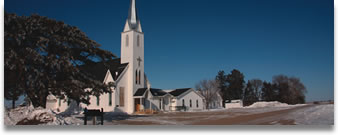 |
Zion Lutheran Church, Tobias, Neb.Photo: Mike Whye |
It’s Not All Downhill!
St. John Lutheran, outside Columbus, Neb., has a problem, and Fred Siefken, its head elder, thinks other rural congregations should know about it.
“We are talking about the growth. At times our facilities are overflowing,” he says. “With rural small-town ministry, we want to make sure the message of our success gets out there and gives hope to other churches that it’s not all downhill in rural America.”
|
|
|
Rev. Brad BirtellPhoto: Mike Whye |
Siefken dismisses the notion that everybody in rural areas has a church home: “There are plenty of people to
reach in our area. I don’t think we are closed to anybody.” He says members of St. John make the most of opportunities to witness and to invite friends, neighbors, and co-workers to their church.
“They come, and they like what they see,” Siefken says. “It has to be centered on the Word. Some people would say it’s style of worship, but no, it’s not that. We are using a more traditional worship service. People come to hear the Word.”
It wasn’t always that way.
Recovering Joy
Fifteen years ago, the congregation, about 80 miles west of Omaha, was deeply conflicted and had lost a quarter of its membership. “The spirit of joy had really been lost,” recalls Rev. Brad Birtell, who became pastor in 1996. “The task that God gave me to do here was to restore hope and joy and credibility to the office of the ministry. The challenge was to bring back what it means to daily celebrate the life Jesus has given in our Baptism.”
During his first years at St. John, Birtell made countless home visits to connect with the members. Yet, he believes the congregation’s youth were responsible for beginning the turnaround.
That first summer, nine high-school youth decided to make a mission trip to the White Earth Indian Reservation in Minnesota to teach Vacation Bible School and participate in other activities with children. Their vision was expanded and their hearts were touched by the experience of sharing the love of Jesus.
The St. John–White Earth connection continues every summer. A smaller group also visits suring the winter, distributing hats, coats, and mittens while they teach Bible lessons. The youth have made other mission trips, too, including trips to New Orleans for post-hurricane cleanup.
“They got us to look out beyond ourselves,” Birtell says. “The kids have been the catalyst: they keep our eyes on the mission field beyond us.”
Over the years, many of St. John’s youth have become church workers, Birtell adds. Those who stay in the area become leaders in the congregation. Those who move away become leaders in their new congregations, he adds.
|
|
|
Rev. Birtell credits the youth of his congregation with beginning its turnaround.Photo: Mike Whye |
“We are training kids up either for full-time church work or to go into congregations wherever God plants them and be vital living parts of the body. It’s an awesome deal all the way around.”
Right now, St. John has nine youth attending Concordia universities.
Birtell insists that St. John is hard to find among corn and soybean fields on winding country roads. Yet, the rural congregation is growing, and Birtell calculates the average age of new members “is definitely in their twenties.” Young people build relationships, he explains, adding that those who work “in town” tell their friends how St. John has affected their lives.
Organized in 1879, St. John counts an average worship attendance of almost 200. Its Lutheran school has three teachers and enrolls 33 students in kindergarten through eighth grade.
St. John also maintains a preschool and a daycare center.
“I think one of the most important jobs a pastor can do is equip his people with God’s Word and then get out of their way and let them use their gifts and abilities for the upbuilding of God’s kingdom,” Birtell says. “I’ve been blessed because I’ve been here long enough to see people develop and use these gifts.”
Siefken lives in the house where he grew up. He runs a calving operation and farms 500 acres. A lifelong member of St. John, he observes this about rural ministry: “It’s typical of rural ministry and maybe a little bit of our downfall—people think they have to be born into the congregation.”
St. John’s members, he adds, have learned how to invite: “Many of our members are not from this area, but they feel welcome and a part of the congregation.”
St. John’s difficult time more than a decade ago may have been a blessing, Siefken reflects. “Pastor Birtell is doing a great job equipping our youth, and everyone here feels empowered by his example.”
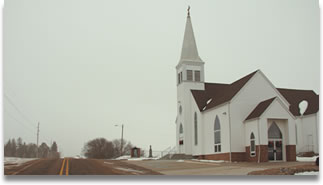 |
St. John Lutheran ChurchPhoto: Mike Whye |
Discovering Hope and Joy in the Ministry
Probably the biggest thing I hear from congregations and pastors is that this has given them hope for the future and joy in ministry,” says Dr. Terry Tieman of LCMS efforts to revitalize LCMS congregations in which worship attendance is on a plateau or slipping downward.
|
|
|
Dr. Terry TiemanPhoto: David Berner |
Revitalization guides congregations through a process of looking outward instead of inward. It helps congregations rediscover God’s mission, which is to reconcile all people through His Son, Jesus, and to bring them into a relationship with Himself.
In a special partnership, Tieman serves as director of mission revitalization for LCMS World Mission as well as being executive director of the Transforming Churches Network (TCN). TCN is working with 30 LCMS districts to train consultants and coaches and prepare study materials.
About 320 congregations are involved in the process, which includes learning communities for pastors who later lead similar communities for congregational leaders. The one-to two-year process includes a weekend consultation to identify five strengths and concerns and outline five “prescriptions.” If a congregation chooses to continue in the process, the district assigns “coaches”—one to work regularly with the pastor and another to work with the congregation.
Most current projects involve urban and suburban congregations, and TCN is working with the LCMS Rural Ministry Task Force to incorporate adaptations to fit the needs of rural and small-town congregations.
“We’ve seen some remarkable things,” says Tieman, citing increases in worship attendance, offerings, Baptisms, confirmations, lay leadership, and community involvement. Most important, he said congregations find hope that they can continue to function and have joy in carrying out the mission of God and the ministry Jesus gave them.
For more information, contact your LCMS district office or visit TCN’s Web site: TransformingChurchesNetwork.org.
About the Author: Roland Lovstad is a member of Immanuel Lutheran Church, Perryville, Mo., and an editor-at-large for The Lutheran Witness.




